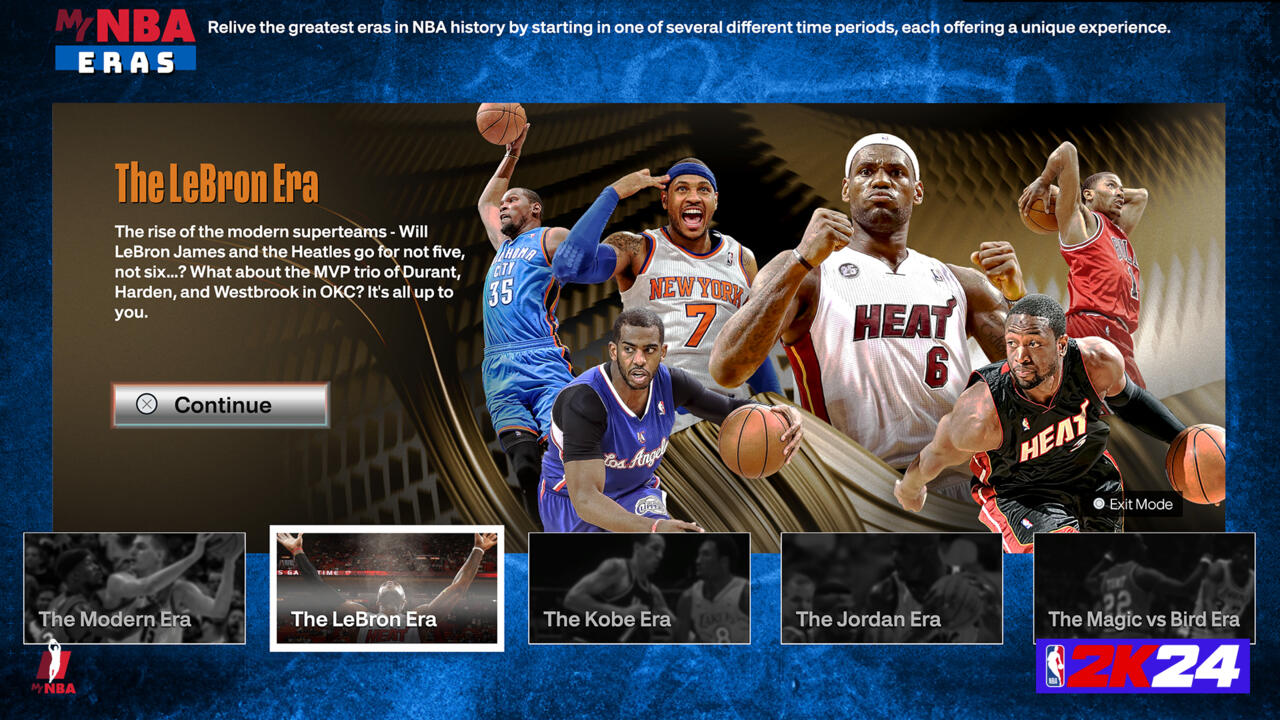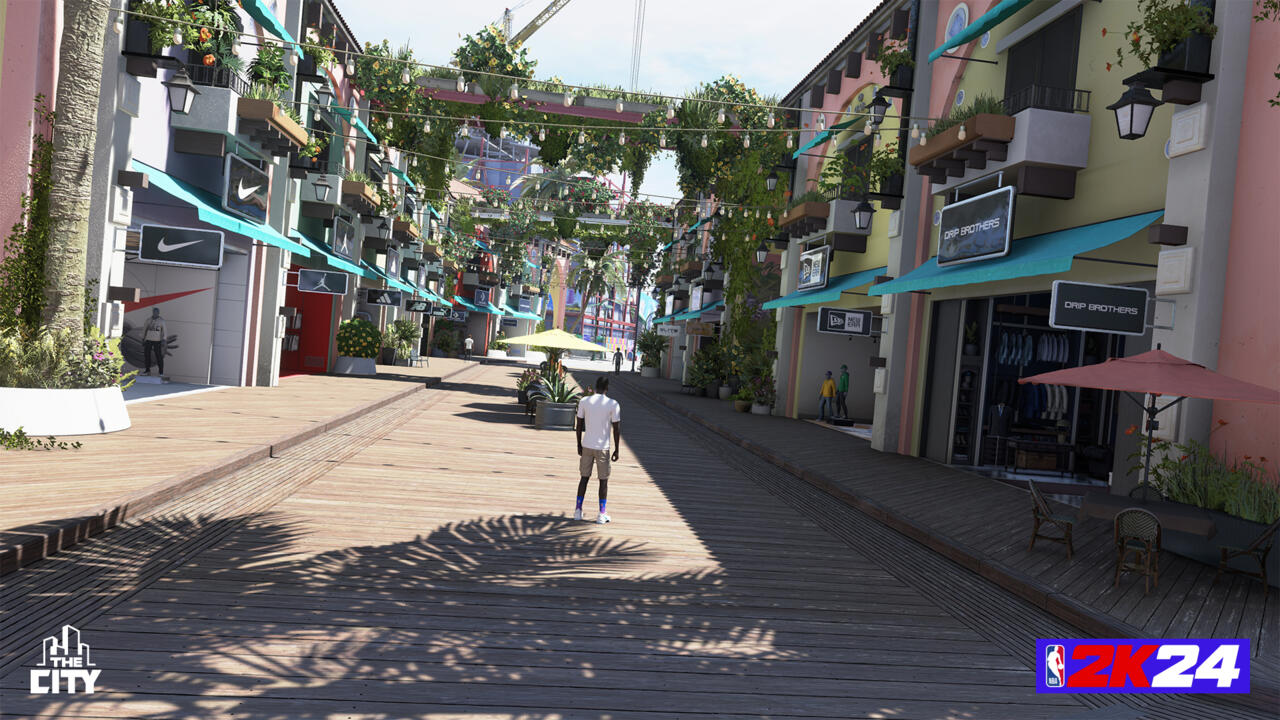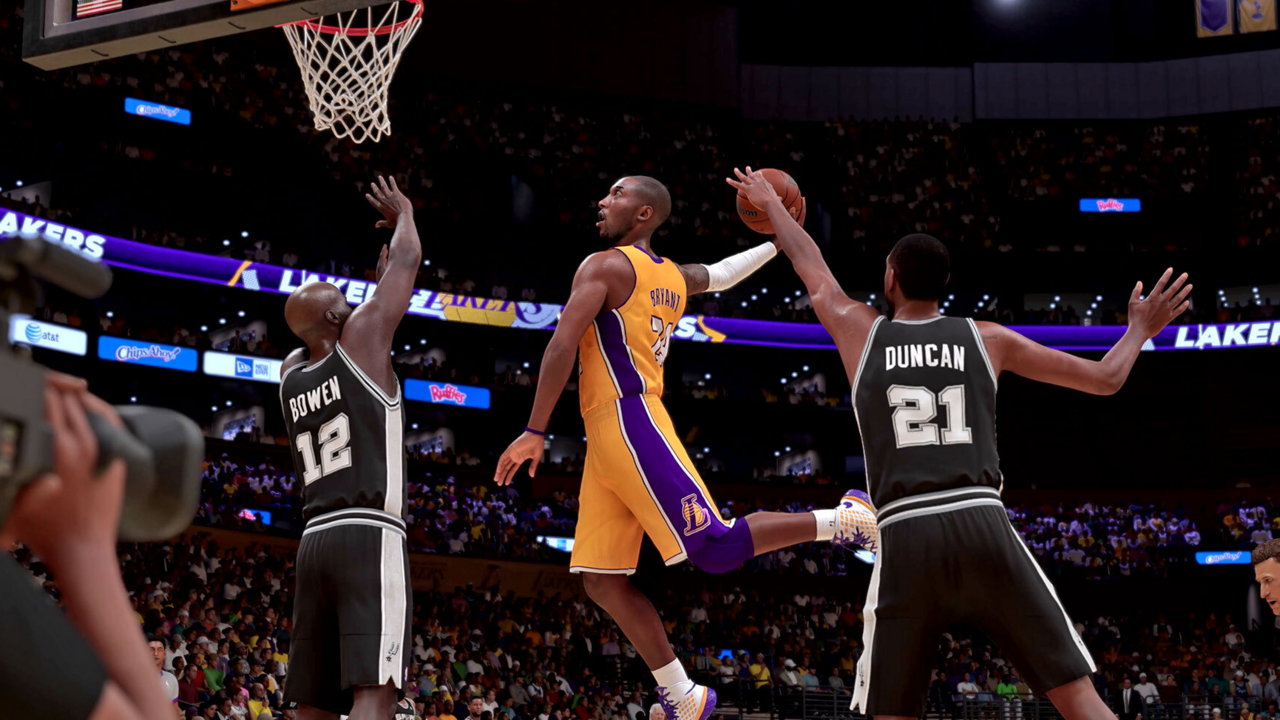Some sports game franchises often have their problems attributed to a lack of competition in their respective genres. Fans will proclaim that certain sports sim series would be better if only they were up against a similar product when players went looking to buy one. NBA 2K hasn’t had a consistent competitor for most of the last decade, and it’s been a reliably fun simulation of basketball regardless. That is still largely the case in NBA 2K24, but the eminently enjoyable on-court sim is hampered more than ever by the game’s pay-to-win economy.
In NBA 2K24, the mainstays of MyCareer, MyTeam, and MyNBA return, and even last year’s Jordan Challenge gets a pseudo-sequel in Mamba Moments, shifting the spotlight from the GOAT to Lakers legend Kobe Bryant. But Mamba Moments winds up emblematic of some of 2K24’s issues: It’s noticeably less interesting and less involved than that which came before it. Maybe some of that is owed to the fact that Bryant’s career achievements can’t quite stack up to Jordan’s, so the figurative ceiling for a mode that lets you recreate some of his greatest career moments isn’t going to be nearly as mesmerizing.
But even then, Mamba Moments lacks some of the attention and care this studio normally pours into its new toys. Unlike Jordan Challenge, Mamba Moments doesn’t feature interview segments with players, coaches, and broadcasters who were pivotal to each chapter of the Jordan Challenge’s story. Bryant’s legacy mode doesn’t get the same documentary-style treatment, and only about half as many games–seven–are playable this time. That makes it a shorter and less robust mode, though other fun details like era-appropriate presentation and well-researched in-game commentary remain. I was impressed when the color commentators started talking about a travel delay the Lakers suffered due to inclement weather some 20 years ago. As ever, this studio has done its homework, and it shows.
In MyNBA, the changes are similarly smaller after last year’s big leap. NBA 2K23 introduced Eras, the ability to begin a franchise in previous decades with accurate rosters, rulebooks, and visual filters. NBA 2K24 returns this hopefully permanent element, but merely adds one new starting point: the LeBron Era, which highlights the arrival of NBA superteams like the Miami Heat and all that have followed in the years since. That’s a worthwhile gap to fill in, but not as notable as last year’s huge introduction of the idea.
To be fair, the work that is involved in the Eras feature is unique to this series, and clearly a painstaking process as well as an ultimately rewarding experience for players. Perhaps there’s nowhere else to go with the idea, though, which certainly feels true of the best-in-class presentation. NBA 2K has long looked and sounded exactly like a real NBA game in a way no other sports sim really touches. Commentary is full of life and tons of variety, including multiple commentary booths, so you’ll hear different voices across different games. The highlight reels, stadium atmospheres, and legitimately funny halftime shows are all remarkable, even if the series feels like it’s peaked in this regard. It’s an impressively accurate simulation of the way basketball is presented on television, and it’s hard for me to find flaws in its approach, even though I’d have said the same thing a few years ago and little has changed in between. Against itself, NBA 2K’s presentation can almost be taken for granted because of that. It’s not until I jump over to other sports games where I most appreciate how well this studio replicates live basketball.
This has never been truer than it is on the court, too. This year, the 2K team is touting technology it calls ProPlay, which somehow–AI is my guess–transposes real-life NBA game footage into animations within NBA 2K24, supplementing motion-captured animations with the real thing. For years, the team has talked about how every basketball player is unique in how they move and play the sport, and why then it’s a focus to accurately recreate those individuals when players control them. Given the team hasn’t explained in great depth how this feature manages to do that, it’s difficult for me to know how much to attribute this game’s improved feel to ProPlay versus, say, the usual fine-tuning an annual sports game tends to receive anyway. But whatever the origin may be, it’s obvious that this game feels great in my hands.

When I first started playing, I could sense a difference, but to really qualify it, I played 2K24 side by side with 2K23. I found that it’s best felt in how body momentum is simulated. Even as a great sim in its own right, last year’s game feels more arcade-like compared to this year’s game. Backpedaling on a change of possession, strafing to clamp down on defense, and hitting that extra level on a fast break all now benefit from more fluidity and range, making the shiftiest players stand out even more and giving all players a more lifelike feel on the controller.
NBA 2K24 is simply a joy to play on the court. It’s an impressive feat given how strong the game already felt to play before, but I liken it to how gamers tend to marvel at visuals and struggle to imagine them ever improving, only for those visuals to blatantly and dramatically improve just a few years later. Maybe in that same light, this team will find new ways to enhance presentation and the Eras features in future years–even if, for now, they’ve plateaued at an apparent yet impressive summit.
However, like most years in recent memory, NBA 2K24 is a great basketball sim being dragged down by its in-game economy. On one hand, this is somewhat partitioned in MyTeam, the game’s card-collecting mode that allows players to slowly build (or quickly buy) fantasy teams for use in PvE and PvP modes. It’s the latter mode that continues to hurt the game–the genre, really–as the mode is unapologetically pay-to-win. Players who wish to cut the line can usually buy the team they want or something similarly flawless at the cost of their bank account balances. The game’s premium versions sold in stores come pre-loaded with tons of Virtual Currency (VC), which can quickly take a team from the mid-60s overall to something in the 80s, circumventing a weeks- or months-long process for a day-one fee. Plenty do this, and they quickly flood the mode with incongruous matchups as a result.
Sports games could feasibly separate the spending whales from the free-team players in matchmaking, but then that latter group wouldn’t feel the urge to keep up with the Joneses and spend too, nor would the whales enjoy dominating free teams as often as they may. We’re left with a lopsided player base that isn’t fun, at least as someone unwilling to invest in the mode. While MyTeam Points, the game’s formerly strictly earned currency, is now doled more often, that too is for sale for the first time ever, quite comically, giving players yet another way to pay their way to the front of the line and the top of the standings.
On top of that, the game introduces a new paid battle pass system that locks away some cards behind a paywall. The first season is also only six weeks long, which is considerably shorter than seasons in many of the other most popular games using battle passes, which tend to cycle through seasons roughly every 8-12 weeks. That means more paid battle passes per year, and more locked-away cards within each of them. NBA 2K is not alone in committing offenses like these, but it may be the worst offender of the sizeable group.
In The City, players make purchases, not memories.
That’s because NBA 2K is uniquely equipped to perform this predatory tactic elsewhere in the game. The City (previously The Neighborhood), the MMO-like social space, has long been the live-service focal point of the game, and it’s something no one else in sports gaming is yet able to match. While many players may buy the game only to play MyNBA or another mode, the game’s year of updates and attractions are largely built around The City, and the community flocks to it as a result. In 2K24, The City looks like Miami but behaves like a Florida swamp, submerging players in an expensive quagmire of branding opportunities and VC that won’t carry them as far as it once did.
The prime example of this is in how much VC players need to improve their player. While playing with one’s created player across both The City and MyCareer will slowly reward players with VC, the trickle is much too slow for the game’s lively community, so many players elect to quickly invest hundreds of thousands of VC, translating to upwards of $100, into their players. In recent years, the game’s premium edition included 100,000 VC (about $50 if bought separately) and would get players to jump from a 60 overall to roughly an 84 overall depending on their player and specific build. In NBA 2K24, the same amount of VC only gets players to about 75 overall.
That means more real money will be spent by anyone hoping to skip the slow climb toward greatness and jump right into competing in the game’s PvP modes like street play and Pro Am. And VC isn’t just spent on improving players or fantasy teams. It can also be spent on a long list of in-game branded items from Nike, Under Armour, Adidas, and many others. The City is one part social hub where players complete daily challenges, meet up with friends, and move seamlessly between City activities and MyCareer games. But it remains a dizzying hellscape of in-game advertising, boiling player engagement down into a nightmarish shopping mall where Jake from State Farm is unfathomably your buddy and every building is named after a sports drink or shoe manufacturer. In The City, players make purchases, not memories.

For many players, everything revolves around their created athlete, and the game has nurtured such a competitive environment that there’s increasingly more pressure to stay afloat with in-game spending. A keen fashion sense, while not providing a gameplay advantage, does pluck spending money out of the same pool of VC as the performance-altering boosts and stat bumps, collectively resulting in even more spending for players–and that sadly seems to be the point. For all that spending to not go nearly as far in 2K24 only amplifies the long-standing pay-to-win issues that continue to hold back this series.
Without these issues, NBA 2K would be the single best sports game on the market. But its blemishes are not minor. They poison too many parts of the game, especially those that are most important. Pay-to-win problems have reached plague-like proportions in NBA 2K24, and the good things it does don’t feel as big or impressive as last year’s to make up for them. While interesting iterative improvements can sometimes be greater than the sum of their parts, the in-game economy hampers much of the goodwill that may derive from elsewhere in the game. I shouldn’t have to talk about money this much in a basketball game. But in this series, it’s become unavoidable. NBA 2K24 feels like a game made by details-obsessed basketball experts unfortunately hamstrung by bottom-line-obsessed executives.
